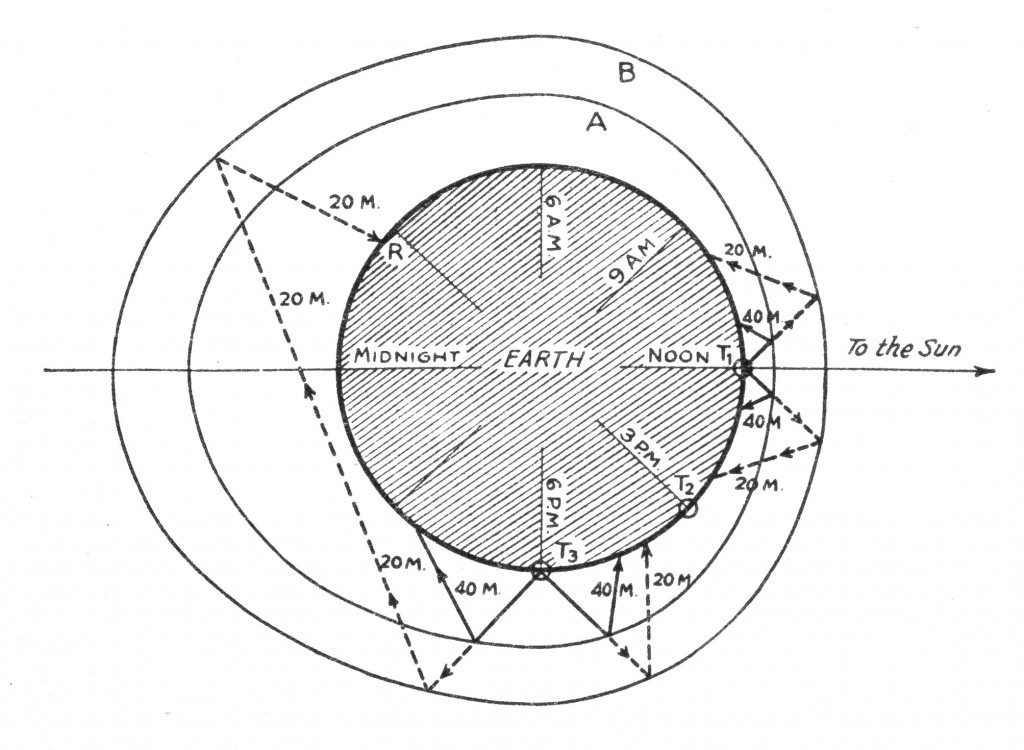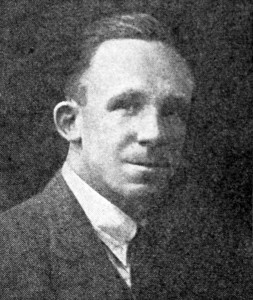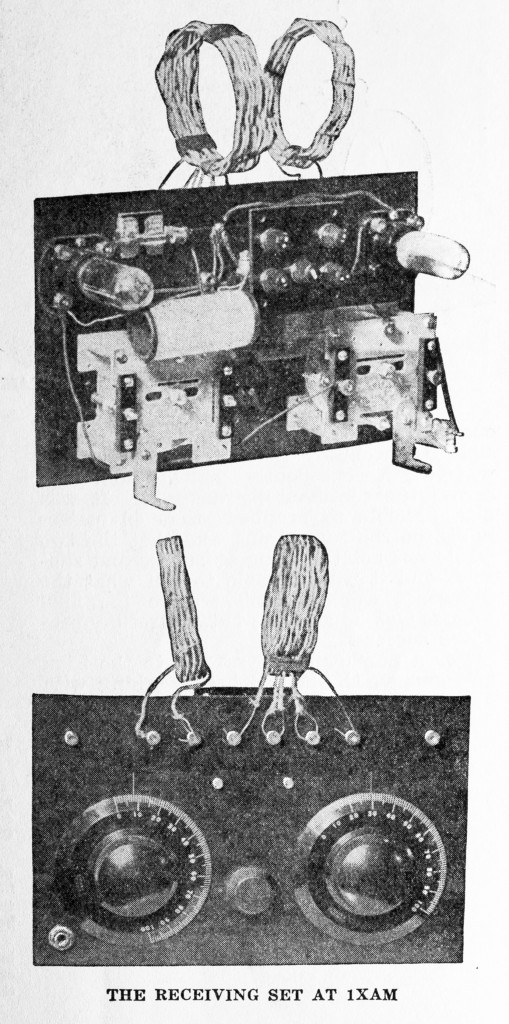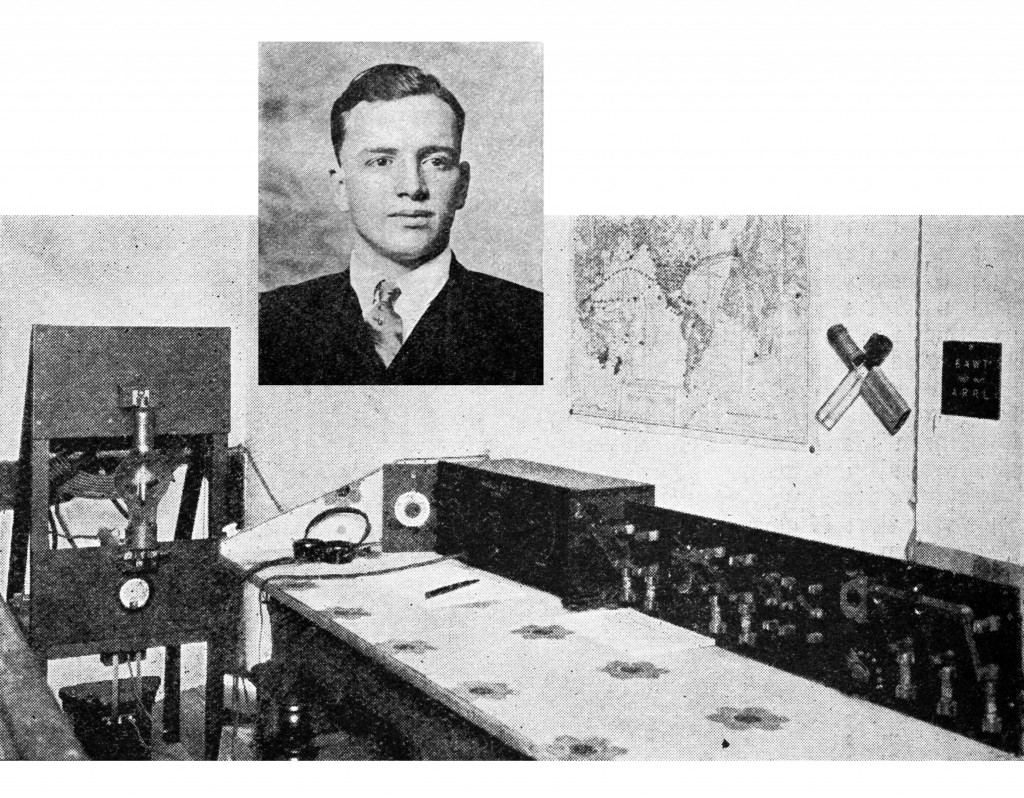…or, The Heaviside Road to the Antipode
Summer 1924 brought the first explorers to the four new, shorter wavelength bands that were opened up to amateur use in July. Amateurs anticipated interesting times ahead based on their earlier experimental work that produced the first transatlantic QSOs. Those had been achieved at 100 meters under special licenses for operating below 150 meters, a region the government designated as “reserved” the previous year without explanation.1
No one knew how the shorter waves would behave, but hams began to form a vague intuition based on understanding the high-altitude atmospheric layers. A long series of experiments during 1924 by John Reinartz at his experimental station, 1XAM, resulted in five thousand reception reports from five European and eighteen North American receiving stations,2 and led to some new insights.
Reinartz wrote that when very short waves were used—say, 20 meters or lower—signals became weaker at night rather than stronger, opposite the case for the familiar wavelengths above 100 meters. Also, signals were often stronger at long distances than short ones. Explaining these behaviors he noted the existence of the Heaviside layer, a conductive shell of upper atmosphere that reflects radio signals3. It was believed that at lower altitudes air is a conductor in the daytime but becomes an insulator at night, due to the sun ionizing the air in the daylight hours. Therefore, the reflecting layer was at a lower altitude in the daytime than at night. His tests tended to confirm much of this but also suggested some modifications to the theory.
Reinartz noticed there were two sides to the propagation-limiting phenomena. At noon there was a minimum wavelength in the vicinity of 50 meters below which no signals propagated regardless of the power level, falling off in strength within a one-meter change in wavelength. At the opposite extreme, there was a maximum wavelength above which signals would also fall off. Thus there seemed to be a band or window of wavelengths that could get through at mid-day, and the whole window would move upward (in wavelength) as the day wore on.
He also observed that in daylight there was a region near a transmitter where its signals could be easily heard, followed by a broad range of distances in which there was no signal, followed by a much greater distance where signals could again be heard. The second, longer receive distance was, of course, the more interesting one.

Reinartz view of reflections and layers
This distance tended to be shorter toward the east than toward the west before noon, about the same in both directions at noon, and reverse after noon, following the sun. Also, the wavelength of the window would move lower in the morning, then increase in the afternoon.
His analysis of reception reports also suggested that different frequencies were reflected from layers of different heights at any given time of day. Reinartz speculated that if higher frequencies penetrated further into the reflection layer than lower frequencies, that would account for the frequency dependence on distance. In all of this analysis he was considering only a 45° radiation angle.
Another useful way to view these propagation zones was as concentric rings surrounding a transmitting station. The short, dead, and long zones formed circles around the station at noon, became elongated towards the west in the morning and toward the east in afternoon. Following this logic, the circles were also elongated away from the equator at any particular time of day. Reinartz concluded that if this theory held it should be possible to pick an optimal wavelength on which to best communicate with any given distance on the earth depending on the time of day—an essentially correct view, lacking complications not yet understood.
But he failed to reason that if ever shorter wavelengths penetrated further into the reflecting layer, there might be a wavelength above which they never reflect but shoot right through. He asserted with confidence that 1925 would “see direct international contact on waves below 1 meter.” He also conceded that amateurs were just beginning to probe propagation phenomena and only through continued experiments at short wavelengths could they gain a more thorough understanding.
In “Editor’s Notes” following Reinartz’s article, technical editor R. S. Kruse added ideas about radiation angle and its effects on propagation distance when radio waves travel through a diffuse refracting layer, as opposed to a reflecting one, thus rounding out the theory.
H. A. Joyce of the University of Detroit later proposed to build further upon previous theory by Reinartz and Kruse.4 He may have been the first to link shortwave reflection to similar refraction and reflection of light from interfaces, such as can be seen in a glass of water, leading to a discussion of the radiation angle of vertical antennas of various lengths. Joyce used simple geometry to approximate the height of the atmospheric reflecting layer by using the radiation angle and the distance of the received station.
![]()

Frank Bell, z4AA
As fall turned to winter in late 1924 and DX work accelerated, new records were set at a rapid pace. Word spread and amateurs worldwide were entering the shortwave realm in increasing numbers, not just in the US. “The laurels in this little old game of amateur radio no longer belong to America,” reported Warner.5
On 19 October a sheep farmer named Frank D. Bell in Palmerstown South, New Zealand, made contact as z4AA with C. W. Goyder, g2SZ, at Mill Hill School, London for a 90-minute QSO on 92 meters. Six days later, Ralph Slade of Dunedin, New Zealand was in contact with British 2NM, Gerald Marcuse (IARU VP)—an 11,900-mile new distance record.
Several US–NZ QSOs were also made, and would normally have been a big deal, had they not been overshadowed by the UK–NZ contacts. “It is staggering!” exclaimed Warner. “Unless somebody can arrange to get into communication with a ship diametrically opposite his station on the other side of the earth, carefully arranging to achieve the world’s maximum of 12,500 miles, it is very doubtful if this record will ever be exceeded,” he wrote, failing to anticipate long-path propagation.
However, shortly afterward, R. Y. Orbell, z3AA, took a station to sea, sailing from New Zealand to England on an easterly route that took him past Cape Horn into the Atlantic, while in constant contact with home. “Why, if the New Zealanders can follow z3AA across the Atlantic to England they will have succeeded in working around the world in both directions, for the g2SZ–z4AA communication apparently occurred over a line east from Greenwich!” wrote Warner, although how he knew this he did not say. Presumably it was because that was the nighttime path, as the prevailing theory would predict. He added that “anybody willing to outfit a floating shortwave ham station under the Stars and Stripes and send it to the Antipodes6 of good U.S. stations, please communicate with ARRL Headquarters. There’s a mathematical possibility of exceeding this British-New Zealand DX record by 600 miles and a chance in a million of doing it.”
As 1924 concluded, reports arrived that several new countries had been added to the list of those known to be active on the new amateur bands:7 Station c1AR in Halifax contacted b4YZ in Belgium for the first contact between North America and that country. c1AR also made the first North American contact with Sweden, working SMZS in Stockholm. Bermuda had an amateur licensing process in the works but was not yet on the air. WJS in Brazil made a first US contact with the Stanford University station, 6OI, in December. There was a first report from British South Africa of receiving US signals there. In India, an amateur received signals from US station 1AAC in QSO with z4AA in New Zealand. 1KC in Northampton, Massachusetts worked GHH1 in Mosul, Mesopotamia for the first contact with Asia since the still-unconfirmed 7HG contact with JUPU a year earlier. He also worked fAIN in Casablanca on Christmas Eve for the first QSO with Morocco. American 2BY worked EAR2 for the first contact with Spain. Denmark joined in, when d7EC contacted u1MY in East Hartford in November, passing several messages.8 And on it went.
On 8 December, the Haverford College, Pennsylvania, chess team played a game via amateur radio with a team from Oxford that had travelled seventy miles to the home of Marcuse at g2NM. u3OT hosted the Haverford side. It was not the first chess game played on the air but was certainly the first international one. (Haverford had previously played chess with a group at the City College of New York.) The two stations tested conditions at various wavelengths finally arriving at sufficient reliability on 85 meters. The game did not conclude but went for 5-1/2 hours and eleven moves for each side at which point the two sides agreed to continue in January. Warner wondered whether “Godley ever thought that just a few years after his memorable visit to England we would be playing 5-1/2-hour chess matches across the puddle.”
International QSOs were now occurring nightly between all continents, all in the wavelength range of 75 to 100 meters, still only a small step beyond the previous year’s work.
UK and NZ stations now in regular contact at dawn and dusk, respectively, reported that it was easier than contacting the US and attributed that to “antipodal effects” rather than the as-yet unknown gray line propagation. It also implied that the signals were going via the long path, throwing most commonly held notions of DX limits out the window. This alone should have ended all the talk about antipodes.
“With thus auspicious a curtain-rise, who can say what this season has in store for us? Apparently there is no end to the possibilities. Just think, we haven’t plumbed the shorter-wave bands yet!” wrote Warner.
What he referred to as shorter wavelengths were still largely a mystery. Recent tests demonstrated that 220 miles could be covered on 40 meters in daylight—something not possible on any other wavelength, as far as was known, making the band very interesting to experimenters. Referring to 20 and 5 meters as extremely short wavelengths, at this point they were touted as being free from interference and nothing more.
To encourage amateurs to explore the new allocations, the ARRL established awards for experimental operation, one for each new band.9 The rules emphasized low power operation and limited transmitters to using a single tube rated at five watts. Because directly measuring power was not yet easy to do, the rule was based solely on tube specifications. If you bent the rules you risked burning out an expensive piece of equipment.

The “contest” period (it was called that despite being billed as an experiment) would run nearly four months, from 1 February to 25 May 1925. It was not fully QSO-based as contests are today. Contacts mattered, of course, and counted in the score, but the event was more of a “test” like the transatlantics, where one-way communications were the main objective. Any given transmission would be counted for the contest only when a receiving station confirmed it by letter, telegram or postcard and agreed with the submitted transmission log. An entry consisted of complete logs and confirmations of transmissions, diagrams and photographs of the station, and a notarized sworn affidavit attesting to adherence to the rules! Excessively long CQing or other such calls would disqualify an entrant as would violating any of the rules.
A 40 meter award, the Cooper Cup, was sponsored by J. C. Cooper of Atlanta, and 20 and 5 meter ARRL Cups were sponsored by the League itself. The announcement offered very little description of what would constitute a winning entry, but experimentation was key. Kruse emphasized that, although QST had been publishing information about how to operate below 100 meters, the League had no monopoly on ideas. “The way to get somewhere in this short-wave business is not to trail after someone else but to make a trail of your own,” he wrote.
The 20 meter test results were encouraging despite a general lack of adherence to the schedules.10 While no nighttime signals got much further than about 100 miles, daylight QSOs were plentiful; among the best were a QSO between Hoffman, 9EK in Madison, Wisconsin, and Reinartz at 1XAM, who worked each other until signals dropped out around 4:40 p.m. Eastern Time. 6AJF had copied the entire QSO from California, too. Since it was about 2-1/2 years past the solar minimum, they may have randomly hit a particularly quiet string of nights for their test. A few days later the pair made contact again, this time decreasing power to a very low level (8.5 and 16 watts).
On the heels of his QSO with 9EK, Reinartz worked 6TS on 20 for fourteen consecutive days.11 (They worked each other on 40 meters at night on those same days—also something new.) It was all done with standard circuits, no “trickery;” it was just the latest demonstration of the usefulness of the shortwaves. Reinartz was also the first to cross the Atlantic on 20 in a QSO with g5LF.12
But as amazed as they were with 20 meters, they did not yet grasp the band’s full potential. While the tests had provided “brilliant proof that 20 meters is one of the most useful waves we have,” they prematurely proclaimed the “utter worthlessness” of the band at night.13

Molinari and his station, 6AWT
William H. Shick, 2MU, had been listening on 40 meters from his Brooklyn home for some time, logging mostly harmonics. On 2 January 1925, he heard 6TS in Santa Monica and thought it was yet another harmonic until 6TS signed his call and added “40 meters” to his identification. (Such was the pervasiveness of harmonic generation.) Using his one-tube Hartley oscillator feeding a 50-foot-long T-antenna strung between the roofs of apartment buildings, 2MU returned the call. The two city-dwellers established contact around 7:00 p.m., the first cross-country QSO on 40 meters.14
And in February, the first confirmed QSO between the US and Japan took place when 6AWT worked JA2 at the Imperial Naval Academy in Nagasaki.15 Bartholomew Molinari, owner of 6AWT, was a baker who operated from his home on Union Street in San Francisco.16 By the end of the year, his station had been heard in multiple countries on all continents and he had worked all forty-eight states. Not due to any special equipment or antennas, his success rather stemmed directly from pushing to ever-shorter wavelengths, brought about in part by necessity. He had originally moved down to concentrate his operation on 80 meters because with fifty broadcast listeners within a six-block radius of his home, he could not use 200 meters lest he be deluged by interference complaints. He later received the 1924 Hoover Cup,17 following Don Wallace, 9ZT, the year before.
![]()
Taking its cue from the various 1924 shortwave tests, the League organized a mid-summer 1925 test to continue the effort with everyone participating worldwide.18 It was again to be a one-way test, meaning some stations would transmit and others would receive, but no QSOs would be made. This time it would run for three, 48-hour periods, each one devoted to single-band operation on 40, 20, and 5 meters, during 18–19 July, 25–26 July, and 1–2 August, respectively. Transmit schedules would run according to local standard time for each station. A thirty-minute restricted transmit period, a thirty-minute free-for-all period, and a three-hour listening period would rotate in sequence, with six such cycles during each of the two days. As in earlier tests, the restricted periods were reserved for high power stations selected by the League. The organizers urged station owners to provide a continuous watch for the entire period using two or three operators in shifts, so as to get as much experience with propagation as possible around the clock. For similar reasons they advised hams to listen for the same stations during each four-hour time period, noting how each signal changed throughout the day. When transmitting, stations would send a self-assigned code word followed by “test” and the station call sign, all repeated during a thirty-minute transmitting period.
Thousands of stations participated, producing hundreds of logs mailed to ARRL HQ containing data collected on 40 and 20 meters but hardly anything on 5 meters.19 But because of a lack of standards and equipment for measuring received signal strength, and the fact that many reports were incomplete, the usefulness of the data for empirical analysis was quite limited. In fact, no coherent set of conclusions could be made. Nevertheless, the participation level alone demonstrated that “radio is no longer a strictly winter sport,” remarked ARRL traffic manager Fred Schnell.
After the successful 20-meter transatlantic tests, E. J. Simmonds operating 2OD at Gerrards Cross, Bucks, England, cabled Maclurcan, the well known Australian experimenter at 2CM, asking him to construct equipment for the band.20 In April 1925 they began testing on 20 meters (coincidentally on the same day the first IARU Congress opened), resulting initially in several receptions of 2CM in England. Encouraged, they continued testing for two weeks and finally worked each other on 3 May from 0552 until 0715 GMT when Simmonds had to get ready for work. The next day, they repeated the feat and passed three messages, including one to the English prime minister from his peer in Australia, one to Eccles of RSGB from Maclurcan, and one from Eccles to the Wireless Institute of Australia. Simmonds and Maclurcan were then in regular contact.
Recognizing the reality of what he called the “international era” in amateur radio, Warner’s editorial for July 1925 rhetorically asked, “Have we not almost reached the ultimate of amateur accomplishment?” specifically referring to this first daylight amateur QSO between England and Australia—at the antipodes!
Maybe “almost” was his operative word, or maybe each generation redefines “ultimate.” Either way the answer would turn out to be “no.”
![]()
de W2PA
- See “First Band, Top Band.” ↩
- J. L. Reinartz, “The Reflection of Short Waves,” QST, April 1925, 9. ↩
- Several pages later in the same issue of QST, an obituary noted the death of Oliver Heaviside, “one of the greatest mathematical physicists of all time,” on 14 February 1925. ↩
- H. A. Joyce, “How are Short Waves Reflected?,” QST, July 1925, 29. ↩
- K. B. Warner, “Antipodes Linked by Amateur Radio,” QST, December 1924, 14. ↩
- Diametrically opposite points on the globe. See also the “Transpacifics” chapter. ↩
- “This Month’s International DX,” QST, February 1925, 13. ↩
- K. B. Warner, “Super DX,” QST, January 1925, 13. ↩
- S. Kruse, “Three Cups Offered for Short Wave Work,” QST, January 1925, 17. ↩
- Experimenters Section Report, QST, February 1925, 31. ↩
- “Daylight Radio Communication Wins!,” QST, March 1925, 9. ↩
- “Who Was Fist Across on 20 Meters?” QST, July 1925, 30. ↩
- Experimenters Section Report, QST, March 1925, 50. ↩
- “6TS and 2MU First Across on 40 meters,” QST, March 1925, 35. ↩
- Clinton B. DeSoto, “Two Hundred Meters and Down,” The American Radio Relay League, Inc., 1936, 100. ↩
- “6AWT, Hoover Cup Winner 1924” Amateur Radio Stations, QST, May 1925, 54. ↩
- See “What is an Amateur?” ↩
- “Announcement of Midsummer Short-Wave Tests,” The Traffic Department, QST, June 1925, 47. ↩
- F. E. Handy, “The Mid-Summer Short Wave Tests,” The Traffic Department, QST, January 1926, I (The first page of appendix – apparently not currently available in the on-line QST Archive as of January 2014). ↩
- “England and Australia Work in Daylight!,” QST, July 1925, 23. ↩
